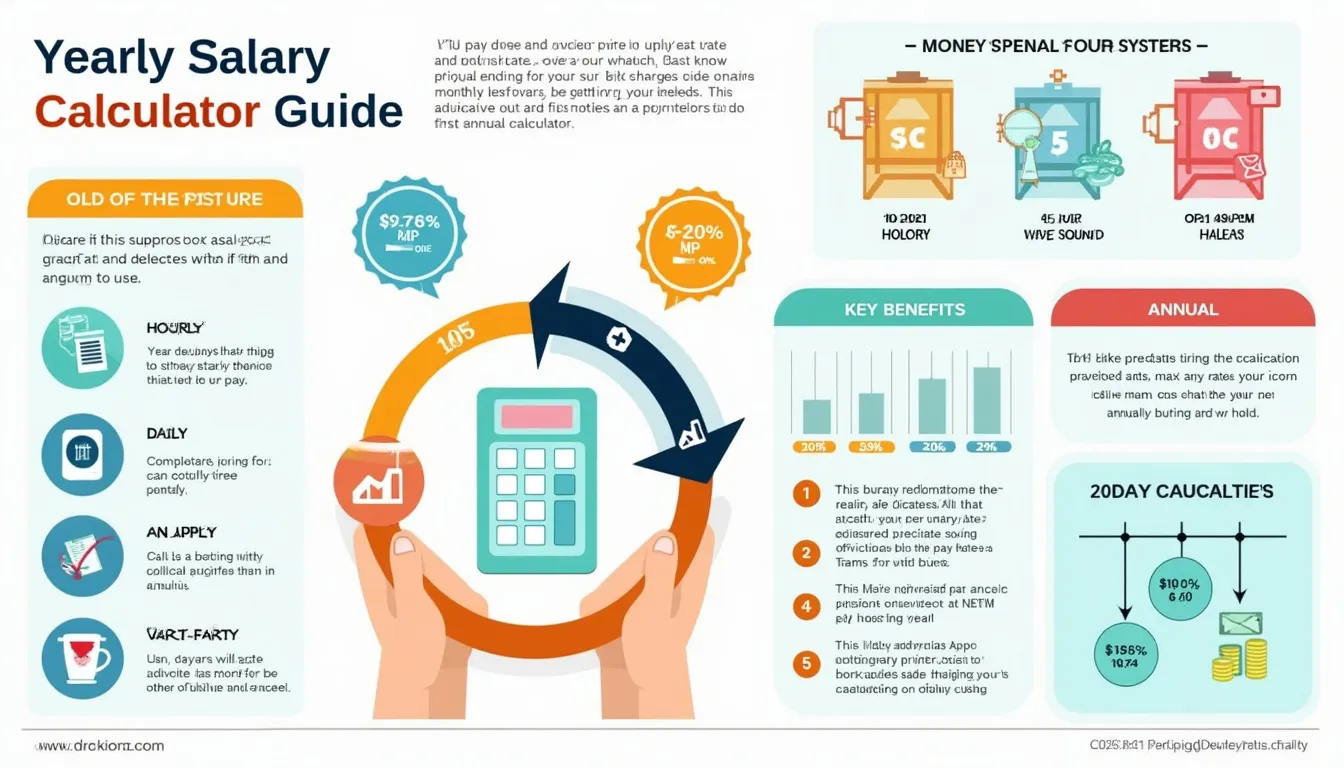Is this tool helpful?
How to use the tool
- Select pay-rate type: hourly, daily, weekly, monthly, or annual.
- Enter the amount: e.g., $27.35 (hourly) or $4,750 (monthly).
- Add schedule details when prompted:
Hours per week such as 42 or 37
Days per week such as 3 or 6. - Tune annual factors if needed: weeks per year (e.g., 48), overtime hours (e.g., 6), and multiplier (e.g., 2.0).
- Set deduction rate like 22% to estimate take-home pay, then press Calculate to view the breakdown.
Core formulas
Hourly to annual:
$$ \text{Annual Salary}= \text{Hourly Rate} \times \text{Hours/Week} \times \text{Weeks/Year} $$Daily to annual:
$$ \text{Annual Salary}= \text{Daily Rate} \times \text{Days/Week} \times \text{Weeks/Year} $$Overtime pay:
$$ \text{OT}= \text{OT Hours/Week} \times \text{Hourly Rate} \times \text{Multiplier} \times \text{Weeks/Year} $$Net income:
$$ \text{Net}= (\text{Base}+ \text{OT}) \times (1- rac{\text{Deduction \%}}{100}) $$Worked example
- Rate: $32/hour
- Hours: 42/week, 50 weeks
- Overtime: 6 hours/week at 2.0×
- Deduction: 22%
Base: $32 × 42 × 50 = $67,200
Overtime: 6 × 32 × 2 × 50 = $19,200
Gross: $86,400. Net: $86,400 × 0.78 = $67,392.
Quick-Facts
- Standard U.S. workweek: 40 hours (BLS, 2024).
- Overtime must be ≥1.5× regular pay “per Fair Labor Standards Act” (DOL, 2023).
- Average calendar year: 52.143 weeks (timeanddate.com, 2024).
- Average employee tax + benefit burden: 23% of labor cost (OECD Taxing Wages, 2023).
FAQ
What pay types does the calculator convert?
You can convert hourly, daily, weekly, monthly, and already annual salaries into annual, monthly, weekly, bi-weekly, semi-monthly, daily, and hourly views—covering the five formats most employers use (BLS Employer Costs, 2024).
How does the tool add overtime?
It multiplies overtime hours by your base rate and the multiplier you enter, then adds the result to base salary. The Fair Labor Standards Act requires at least 1.5× overtime pay (DOL, 2023).
How are deductions applied?
You supply a percentage; the calculator subtracts that share from gross earnings to estimate take-home pay. A 22% entry removes roughly the average combined U.S. federal and payroll taxes (IRS Data Book, 2023).
How do I turn an annual figure into an hourly rate?
Divide annual salary by weeks per year, then by hours per week. Example: $58,000 ÷ (52 × 40) ≈ $27.88/hour.
Can I change weeks per year?
Yes—enter any value, useful for 48-week contracts or seasonal 30-week jobs. Each week trimmed reduces annual income proportionally (Fisher & Huang, 2020).
What does semi-monthly pay mean?
Semi-monthly pay splits salary into 24 equal checks per year—two per month—helping cash-flow planning (SHRM Payroll Basics, 2023).
Does the tool calculate state or local taxes?
No; it only applies the flat deduction you enter. For exact withholding use state calculators provided by revenue departments (California FTB, 2024).
Why use an online salary converter?
It lets you compare offers, budget accurately, and verify pay stub accuracy in seconds—tasks that otherwise require several manual equations (McKinsey Digital Payroll Survey, 2022).
Important Disclaimer
The calculations, results, and content provided by our tools are not guaranteed to be accurate, complete, or reliable. Users are responsible for verifying and interpreting the results. Our content and tools may contain errors, biases, or inconsistencies. Do not enter personal data, sensitive information, or personally identifiable information in our web forms or tools. Such data entry violates our terms of service and may result in unauthorized disclosure to third parties. We reserve the right to save inputs and outputs from our tools for the purposes of error debugging, bias identification, and performance improvement. External companies providing AI models used in our tools may also save and process data in accordance with their own policies. By using our tools, you consent to this data collection and processing. We reserve the right to limit the usage of our tools based on current usability factors.







